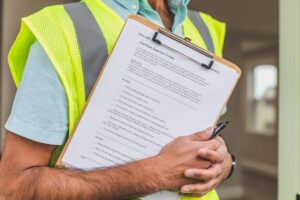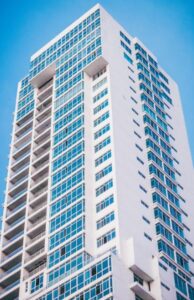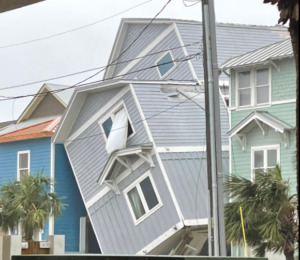Miami-Dade is the Weak Link in Florida’s Roof Underlayment Requirements
The Florida Roofing and Sheet Metal Contractors Association (FRSA) has been at the forefront in making the Florida Building Code’s roofing requirements stronger than any other building code in the country and, quite possibly, the world. The effort is warranted due to Florida’s unique geographical exposure to hurricanes and the need for roof systems that will minimize potential property damage when they occur.
During the development of the 8th Edition (2023) of the building code, the roofing industry and others worked together to improve underlayment performance and, in particular, to bring the more stringent requirements used in 65 of Florida’s 67 counties into the High Velocity Hurricane Zone (HVHZ) sections of the code. The HVHZ is comprised of Miami-Dade and Broward counties only. This area has the potential for the highest wind speeds in Florida based on the American Society of Civil Engineers’ wind speed maps.
For more than two years, we proposed and advanced several modifications to the code that would strengthen and standardize roof underlayments (the membrane between the structural decking and the shingles or roof tiles) for all types of steep-slope roof systems in the HVHZ. A steep-slope roof system is one that has a pitch or slope equal to or greater than 2 units vertical to 12 units horizontal. This effort was preceded by many attempts of people in the industry to work with Miami-Dade County to find a reasonable solution to its lagging underlayment requirements.
We felt these changes were needed not only to achieve better performance of many types of roof coverings but also to greatly improve the underlayments’ ability to serve as secondary water barriers. Secondary barriers have proven to be very effective at preventing interior damage and the displacement of the building’s occupants in the event of a roof covering failure.
Miami-Dade County pushed back against these changes at every opportunity.
The underlayment changes were approved over the course of three of the Florida Building Commission’s Technical Advisory Committee (TAC) meetings. We opposed many attempts by Miami-Dade County to amend the code changes in ways that would have weakened their effectiveness. During four Florida Building Commission meetings (for which a 75% vote is required for approval), our changes were accepted and incorporated into the code that will go into effect on Dec. 31 (for all counties but Miami-Dade and Broward, which were granted their own status by the statutory carve-out in the 1990s.)
One Miami-Dade amendment would eliminate some of the most important changes that had been approved by the Building Commission. It would require a nail-able underlayment over the roof sheathing (wood decking), thereby eliminating the availability of self-adhered underlayment (sometimes referred to as “peel and stick”) installed directly to the deck. (The “deck” is referred to in the code as sawn lumber, wood plank or wood structural panel deck.)
Self-adhered underlayment has been widely accepted by the roofing industry in almost all of Florida for well over a decade. It also has been embraced by the property insurance industry, which offers its largest credits for this type of secondary water barrier. Self-adhered underlayment applied directly to the deck has proven to be very effective and offers very high uplift-resistance values.
The amendment proposed by Miami-Dade County officials – in an attempt to undo what the state Building Commission had already approved – was denied. But the county can still offer its own interpretation and go its own way on this.
A second part of Miami-Dade’s amendment to the code is also very important. It requested a reduction in the tested uplift pressures to -90 psf ultimate. (The building code and the model codes require a safety factor of 2 to account for potential minor material and installation variations or deficiencies, among other things. So, an underlayment that attains a -90 psf ultimate rating in testing is halved to -45 psf.) This amendment was also denied by the Building Commission.
That should have resolved the issue but, unfortunately, it has not and Miami-Dade has stated that -45 psf will continue to be the threshold in the HVHZ.
There is another weak link in the HVHZ requirements for underlayments – those for tile roofs. A recent survey of industry professionals estimated that between 50% to 60% of steep-slope roofs in the HVHZ are tile. Those tile roof systems, as well as low-slope roof systems, are not required to comply with the state code’s secondary water barrier provisions primarily because they have historically been assumed to meet or exceed code-required uplift resistance levels. A system, however, is only as strong as its weakest link. So, if the tile underlayment is not tested to meet ASCE 7 uplift resistance values – as mandated by the state building code – the ability of the entire system to resist high winds is greatly undermined.
Miami-Dade County, instead of complying with the Florida Building Commission’s direction regarding underlayment uplift resistance, has issued its “Checklist #0090 For the Approval of Roofing Underlayment” to give guidance to the roofing industry on how it intends to implement these code changes – or perhaps one should say how it intends to avoid implementing these code changes. A note at the bottom of the checklist document states: “Uplift Testing submitted to support an Underlayment Uplift Design Pressure will accept 1 specimen achieving a minimum -45 psf. (after applying 2:1 safety factor).”
Miami-Dade County has indicated that any tile underlayment that meets this negative pressure will be issued a Miami-Dade County Notice of Acceptance (NOA). Also, the county has indicated that uplift pressures will not be listed in the NOA. We feel that this is a major divergence from the intent of the changes adopted in the new statewide code. The ASCE 7-22 uplift resistance for tile roofs in the HVHZ will very seldom, if ever, face pressures this low in a storm. Pressures two or three times this high are far more common in the HVHZ. The acceptance of -45 psf as the maximum required resistance would definitely result in a severe weakening of the new code.
Why We Should Be Concerned
If allowed to stand, Miami-Dade County’s implementation will not only weaken the new requirements for tile roof systems inside Miami-Dade and Broward Counties but will also have a far broader impact because a Miami-Dade County NOA can be used anywhere in Florida for obtaining building permits.
It is important to be aware of the impact that roof-related losses have on Floridians. All Florida property insurance policyholders act as a backstop for Citizens Property Insurance Corp. (which is the largest provider of property insurance in the HVHZ) and the rest of Florida. Property and casualty insurance purchasers in Florida are already paying a surcharge on their policies to cover claims for a few insolvent insurers. Major hurricane losses by Citizens could, one day, trigger another assessment.
It is clear that we need to do all things reasonable to mitigate potential property damage through stronger building codes. The positive impacts that strengthening code requirements have had cannot be disputed: Post-hurricane damage assessments from many reliable sources have all come to the same conclusion. Sticking our head in the sand is not a viable approach. We simply can’t afford to let Miami-Dade County set the standard, based on the county’s contention that it “hasn’t seen the failures.” Such observations – or lack thereof – completely ignore the fact that they have not experienced a major hurricane since Andrew in 1992.
The damage that we’ve observed in other parts of the state where recent hurricanes have occurred clearly demonstrates that we should not weaken the code for the south Florida HVHZ and, through NOAs, the entire state.
What Can Be Done to Bring Them Around?
If we are going to successfully achieve the important goal of having strong and consistent underlayment and secondary water barrier requirements throughout Florida, we need all affected parties to help. For those of you who represent the insurance industry’s interest, we’ve lessened your exposure by working to strengthen building codes and have pushed back against fraud because we know it’s the right thing to do. If you’re someone who wants improved roof resilience in order to maintain the availability of property insurance with reasonable premiums, you should now consider making your voice heard.
Our position is simple: test tile underlayments to failure, adjust for the safety factor of two and then post those uplift pressures on the NOAs in the same way that we currently do for Florida Building Commission product approvals.
This issue needs to be resolved before the new code becomes effective at the end of the year.
Miami-Dade Response: Need for Different Underlayment Requirements Not Proven
As the local government entity charged with enforcing the Florida Building Code (FBC), Miami-Dade County has and will continue to comply with the most current code requirements. It is in Miami-Dade County’s best interest to protect the health, safety, and welfare of the community by helping to ensure the Florida Building Code is applied and being followed appropriately.
Regarding the 8th Edition of the FBC, it is inaccurate to state that Miami-Dade County “remains reluctant to comply.” The latest edition does not become effective until December 31, 2023, and Miami-Dade County government will comply with enforcing the code as it has always done.
Miami-Dade County opposed the changes to the High Velocity Hurricane Zone (HVHZ) process because evidence that HVHZ roof tile assemblies were blown off during hurricane events were not provided to support a change to the HVHZ process. No such evidence has been presented, nor have we observed such failures in recent storms. Assembly testing of the roof systems did not expose flaws.
Miami-Dade County and requirements in the HVHZ have always required an assembly-style testing approach to qualify roofing systems. Assembly testing is required to qualify roofing tile systems, as well as other systems containing an underlayment.
A roof tile assembly includes several components, which in the HVHZ are tested as a system to attain its performance value. Isolating components for testing to obtain their performance in a system is clearly not indicative of the assembly’s overall performance.
Protocol TAS 101 (Testing Application Standard No. 101, devised by Miami-Dade County) tile system-testing provides a moment-force resistance value, which is the basis of the permitting requirements in the HVHZ. The assembly tested during the TAS 101 includes the wood deck, underlayment, tile adhesive and the roof tile.
To obtain a roof tile permit in the HVHZ, the specific ASCE7 wind design pressures are used in a formula that provides the required moment-force resistance required for the site-specific project. This value is compared to the system’s moment-force resistance value listed on the product approval.
In the HVHZ the system testing application standard protocols, material quality standards, roofing application standards, and the standard roofing permit application are integral in obtaining a quality code-compliant roofing system.
This response was provided by Miami-Dade’s Department of Regulatory and Economic Resources. Lorna Mejia-Lopez is the spokesperson and chief of public engagement and community outreach.
**Article obtained from: Insurance Journal, By: Mike Silvers, Published 11/16/2023
https://www.insurancejournal.com/news/southeast/2023/11/16/748438.htm






